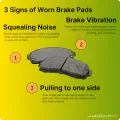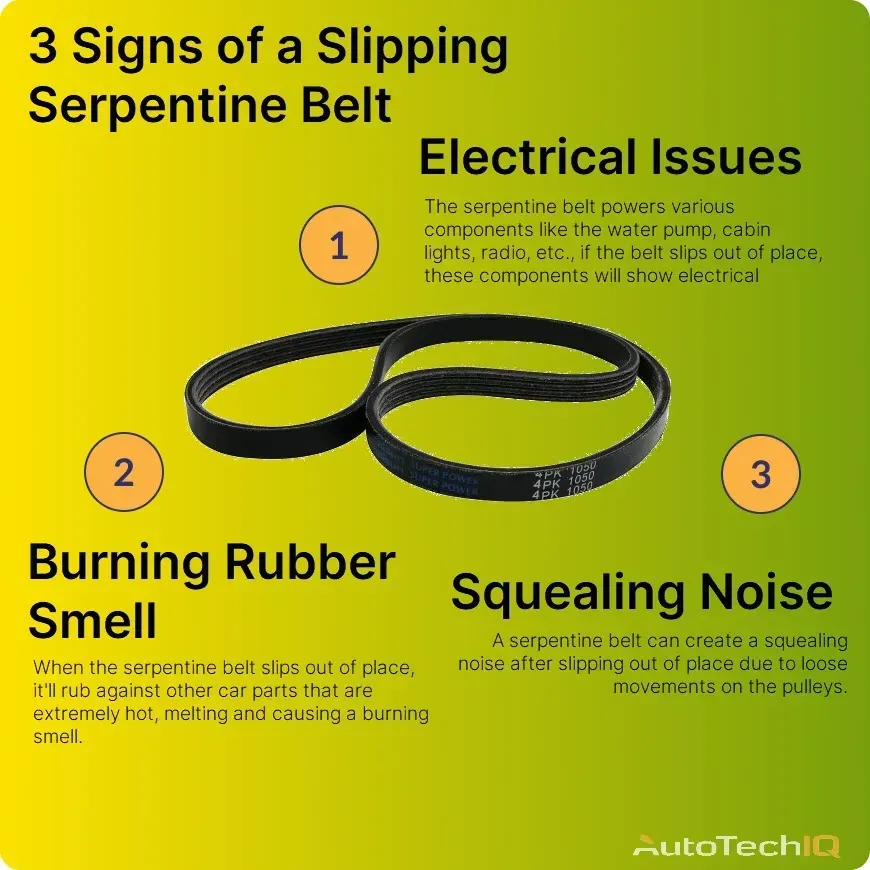

The main sign that your serpentine belt slipped is a burning rubber smell. When this belt overheats, it can burn, producing a distinctive odor. Commonly, this happens because the belt slips out of place and rubs against other hot engine components, intensifying the smell of burning rubber.
Serpentine belts, also known as multi-rib or poly-v belts, are long, looped rubber belts that run along grooved pulleys connected to important engine components like the alternator, power steering pump, air conditioner compressor, air pump, and sometimes the water pump.
-
Key function: Its main job is to transfer power from the crankshaft to different systems, ensuring they function properly. This means the belt plays a crucial role in powering your car's electrical system, air conditioning, radio, lights, and other accessories.
A serpentine belt can slip out of place due to wear and tear, improper tension, damaged pulleys, etc.
-
Safety: The serpentine belt powers various systems responsible for safe driving. So, if the belt slips it might damage the power steering pulley, affecting your steering capacity. Plus, the engine can overheat and eventually stall since the serpentine belt feeds the water pump, which is responsible for circulating coolant.

Electrical problems
The serpentine belt is directly connected to the alternator and it’s an important part of your vehicle’s electrical system. The belt is vital to keep components such as the water pump, power steering pump, air conditioning compressor, radio, accessory lights, etc., working properly.
If the serpentine belt slips out of place, it won’t be able to power these components properly, causing them to malfunction. Therefore, you might start noticing electrical issues such as radio problems, weak cabin lights, and headlights, A/C malfunction, etc.
If the belt starts melting, it might cause damage to pulleys and belts related to the alternator, progressing into a more critical and expensive problem. In extreme cases, problems might start affecting the alternator itself, risking damage to it, which is expensive.
Burning rubber smell
If a serpentine belt slips out of place, it becomes loose and is at risk of rubbing against other car parts. The belt dressing and rubber material might not resist the temperature of some vehicle components that quickly heat up when the car is running. Plus, a slipped serpentine belt can increase the vehicle’s overall temperature damaging the cooling system.
This means not only the serpentine belt but also the alternator and crank pulley can get too much heat and eventually burn or melt.
The serpentine belt powers your vehicle’s water pump. Since the water pump is an essential cooling system component, a properly working serpentine belt, which drives the water pump, helps to avoid overheating.
When cooling systems go bad, the engine has a higher risk of overheating. An overheating engine can damage/burn/melt internal components, eventually leading to different problems.
At most, vital components can deteriorate or wear out faster, risking an engine stalling, which is a big safety concern. You might also notice these warning lights:
Other common signs
Here are other common signs that your vehicle’s serpentine belt might have slipped:
-
Dashboard warning lights
-
Loss of power steering
-
Loss of radio
-
Weak cabin lights
-
Loss of A/C and heater
Possible fixes
-
Radiator replacement: A faulty serpentine belt can indirectly lead to a radiator replacement due to overheating from failing to supply the water pump.
-
Timing belt replacement: A timing belt can suffer from overheating if the serpentine belt malfunctions and stops supplying the water pump.
-
Water pump replacement: The serpentine belt drives power to the water pump; if faulty, the pump might develop electrical issues faster.
-
Serpentine belt replacement: The serpentine belt can slip and damage beyond repair, requiring a replacement.
-
Air conditioning compressor replacement: A serpentine belt powers the A/C compressor; a slipping serpentine belt causes intermittent power and overheating, which can lead to electrical failures.
Frequently Asked Questions
What does a slipping serpentine belt sound like?
A serpentine belt slipping typically produces a high-pitched squealing or whining noise coming from the engine compartment. This sound happens because the friction between the belt and pulleys increases as it struggles to grip, similar to rubbing two balloons together. The pitch of the squeal may change with engine RPM, and it might temporarily go away if you spray water on the belt (be careful though, and don't do this while driving). The recommendation is always to replace the belt with a new one, but if the belt barely slipped without further damage, mechanics try to return the belt tight.
What happens if a serpentine belt slips?
A slipping serpentine belt disrupts the proper functioning of your car's accessories. The belt slip can cause the battery light to come on due to a failing alternator charge, the steering to tighten up from unpowered power steering, and overheating from a non-functioning water pump. You might also hear a high-pitched squeal as the belt struggles for grip. If you notice any of these signs, pull over safely and turn off the engine to avoid further damage; you’ll probably need to replace it with a new belt.
Can you drive with a slipped serpentine belt?
It's strongly discouraged to drive with a failing serpentine belt. While you might limp a short distance if absolutely necessary, the belt powers crucial systems like your battery charging and engine cooling. Continued driving can quickly lead to a dead battery, overheating, and potential engine damage. Call for roadside assistance or tow service to avoid further issues. Also, serpentine belts have specific rubber dressing to deal with the heat at the right location. So, it’s replacing it yourself is not advisable without understanding if you’re using the correct or wrong belt.
Other news
-
Car is Squealing When Driving

-
What is Preventative Maintenance and What Are The Benefits of it?

-
JobViewIQ - DVI Process Training - Part of the Auto Care Alliance Benefits

-
7 Signs of Clogged AC Components
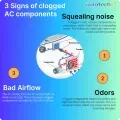
-
How Much Does a Transmission Fluid Change Cost?
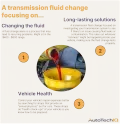
-
7 Signs of a Leaking Axle Seal
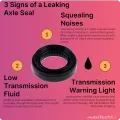
-
8 Signs of a Bad Brake Pad
